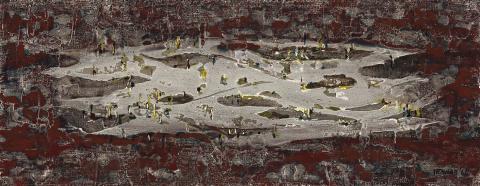COASTAL LANDSCAPE, 1966
HOWARD TAYLOR
pigment, PVA and plaster on hessian on board
29.5 x 75.0 cm
signed lower right: H TAYLOR
Private collection, Perth, a gift from the artist
'Taylor strove to fracture the unity of representation and slow down the immediacy of recognition. By rupturing contiguity in the world of appearances, he sought in his works to create a pause or brief rift in the timing of recognition, so a subject, no matter how traditional, can be seen anew "as a new visual phenomena to be experienced in the present.'1
Howard Taylor was a committed experimentalist who constantly sought new material approaches that extrapolated the sensory influence of the natural landscape. In Coastal Landscape, 1966, thick paint layers form a shallow sculptural relief of restrained colour. A 'rigorously synthesised landscape'2 of exposing sediment, 'his major innovation during this period was the introduction of an actual third dimension in his paintings.'3
Coastal Landscape is subtle yet palpable - a defining quality within Taylor's works. The centralised and symmetrical composition balances the detailed, tactile surface. Taylor stated that 'pictorial work has an infinite number of things pushing and pulling, and your job is to order it in such a way that what you end up with has unity and some significance'.4 In 1967, Taylor relocated from Bickley in the Perth Hills to Northcliffe in the south-west of Western Australia. This places the present offering at an interesting nexus within the artist's career and his ever-refining vision of nature.
1. Dufour G., 'The Inventive Eye', Howard Taylor: Phenomena, Art Gallery of Western Australia, Perth, 2003, p. 24
2. Storer, R., 'In a Silent Way', Howard Taylor: Phenomena, Art Gallery of Western Australia, Perth, 2003, p. 53
3. Dufour G., 'Visual Experience and Pictorial Structure', Howard Taylor: Phenomena, Art Gallery of Western Australia, Perth, 2003, p. 45
4. Taylor, H., 'Interview', Howard Taylor: Phenomena, Art Gallery of Western Australia, Perth, 2003, p. 63
